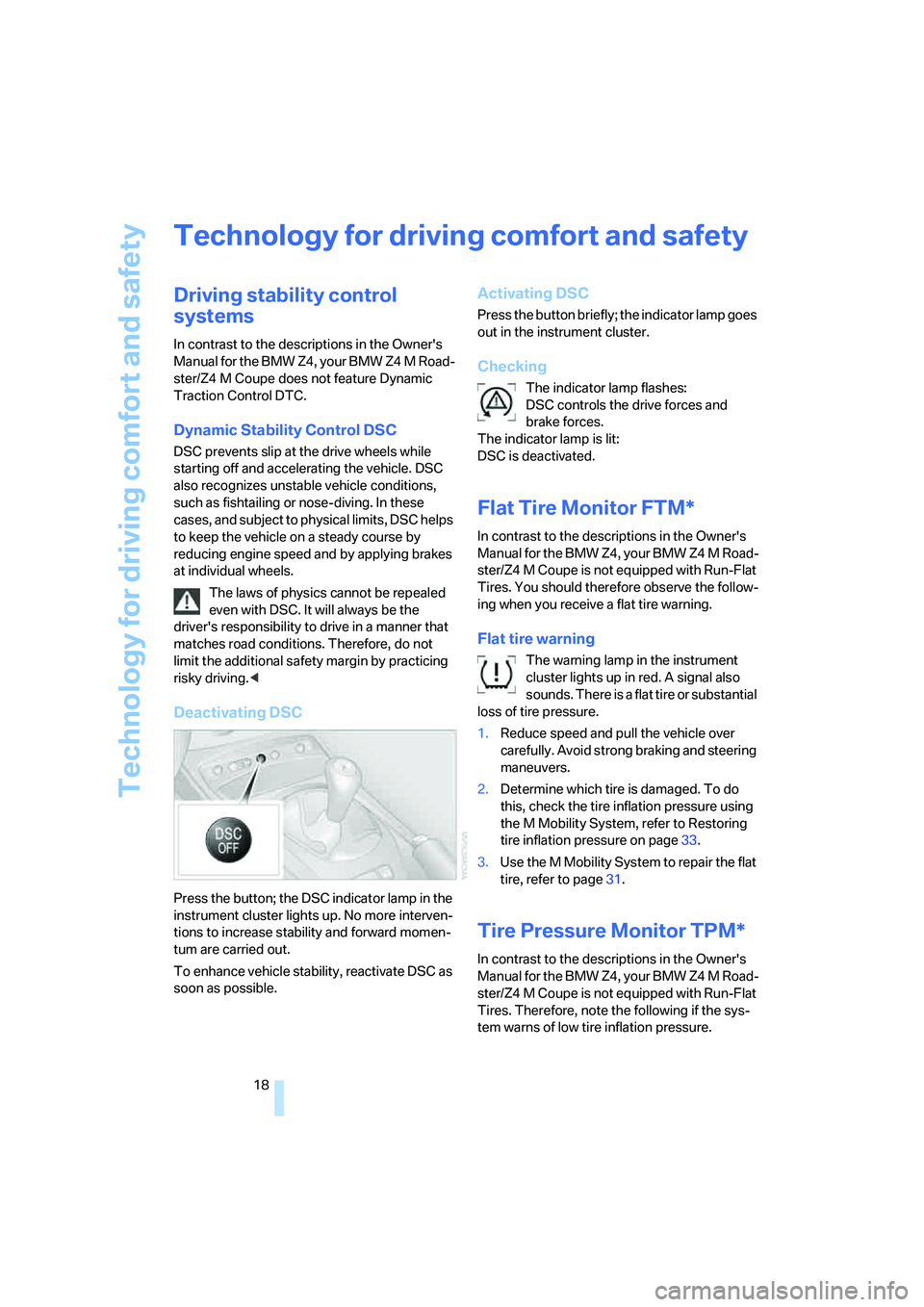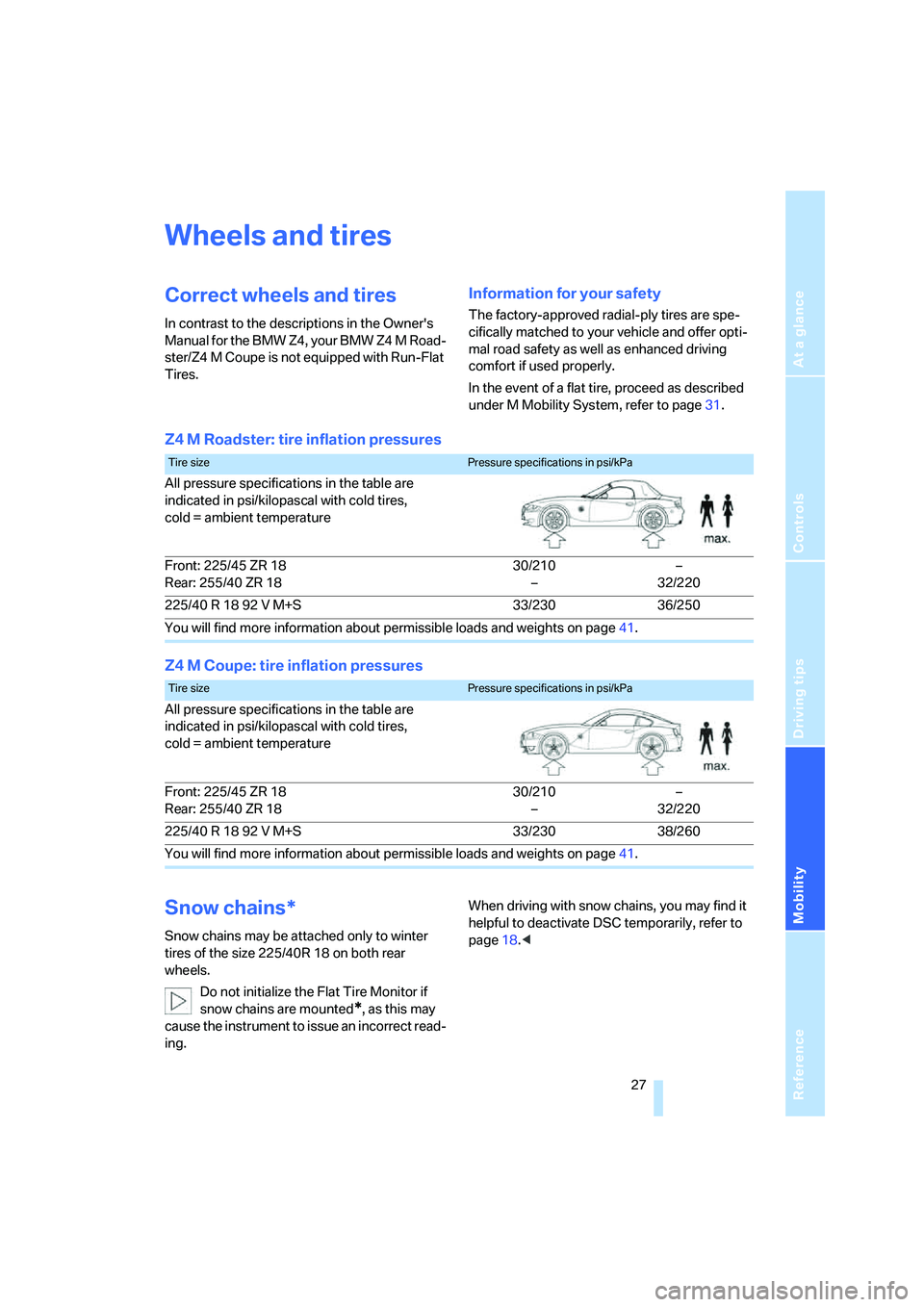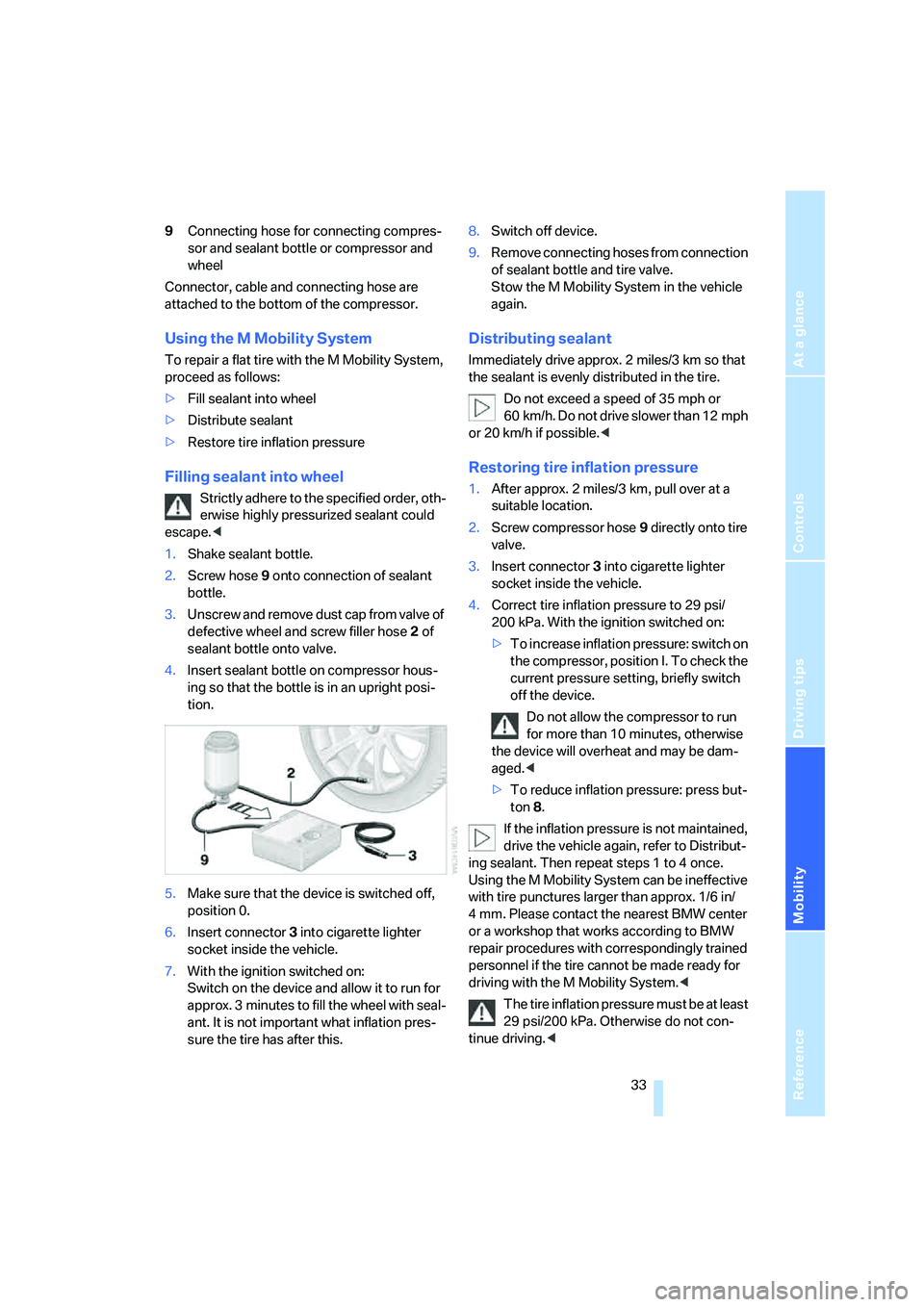Page 20 of 50

Technology for driving comfort and safety
18
Technology for driving comfort and safety
Driving stability control
systems
In contrast to the descriptions in the Owner's
Manual for the BMW Z4, your BMW Z4 M Road-
ster/Z4 M Coupe does not feature Dynamic
Traction Control DTC.
Dynamic Stability Control DSC
DSC prevents slip at the drive wheels while
starting off and accelerating the vehicle. DSC
also recognizes unstable vehicle conditions,
such as fishtailing or nose-diving. In these
cases, and subject to physical limits, DSC helps
to keep the vehicle on a steady course by
reducing engine speed and by applying brakes
at individual wheels.
The laws of physics cannot be repealed
even with DSC. It will always be the
driver's responsibility to drive in a manner that
matches road conditions. Therefore, do not
limit the additional safety margin by practicing
risky driving. <
Deactivating DSC
Press the button; the DSC indicator lamp in the
instrument cluster lights up. No more interven-
tions to increase stability and forward momen-
tum are carried out.
To enhance vehicle stability, reactivate DSC as
soon as possible.
Activating DSC
Press the button briefly; the indicator lamp goes
out in the instrument cluster.
Checking
The indicator lamp flashes:
DSC controls the drive forces and
brake forces.
The indicator lamp is lit:
DSC is deactivated.
Flat Tire Monitor FTM*
In contrast to the descriptions in the Owner's
Manual for the BMW Z4, your BMW Z4 M Road-
ster/Z4 M Coupe is not equipped with Run-Flat
Tires. You should therefore observe the follow-
ing when you receive a flat tire warning.
Flat tire warning
The warning lamp in the instrument
cluster lights up in red. A signal also
sounds. There is a flat tire or substantial
loss of tire pressure.
1. Reduce speed and pull the vehicle over
carefully. Avoid strong braking and steering
maneuvers.
2. Determine which tire is damaged. To do
this, check the tire inflation pressure using
the M Mobility System, refer to Restoring
tire inflation pressure on page 33.
3. Use the M Mobility System to repair the flat
tire, refer to page 31.
Tire Pressure Monitor TPM*
In contrast to the descriptions in the Owner's
Manual for the BMW Z4, your BMW Z4 M Road-
ster/Z4 M Coupe is not equipped with Run-Flat
Tires. Therefore, note the following if the sys-
tem warns of low tire inflation pressure.
Page 29 of 50

Reference
At a glance
Controls
Driving tips
Mobility
27
Wheels and tires
Correct wheels and tires
In contrast to the descriptions in the Owner's
Manual for the BMW Z4, your BMW Z4 M Road-
ster/Z4 M Coupe is not equipped with Run-Flat
Tires.
Information for your safety
The factory-approved radial-ply tires are spe-
cifically matched to your vehicle and offer opti-
mal road safety as well as enhanced driving
comfort if used properly.
In the event of a flat tire, proceed as described
under M Mobility System, refer to page31.
Z4 M Roadster: tire inflation pressures
Z4 M Coupe: tire inflation pressures
Snow chains*
Snow chains may be attached only to winter
tires of the size 225/40R 18 on both rear
wheels.
Do not initialize the Flat Tire Monitor if
snow chains are mounted
*, as this may
cause the instrument to issue an incorrect read-
ing. When driving with snow chains, you may find it
helpful to deactivate DSC temporarily, refer to
page
18.<
Tire sizePressure specifications in psi/kPa
All pressure specifications in the table are
indicated in psi/kilopascal with cold tires,
cold = ambient temperature
Front: 225/45 ZR 18
Rear: 255/40 ZR 18 30/210
– –
32/220
225/40 R 18 92 V M+S 33/230 36/250
You will find more information about permissible loads and weights on page 41.
Tire sizePressure specifications in psi/kPa
All pressure specifications in the table are
indicated in psi/kilopascal with cold tires,
cold = ambient temperature
Front: 225/45 ZR 18
Rear: 255/40 ZR 18 30/210
– –
32/220
225/40 R 18 92 V M+S 33/230 38/260
You will find more information about permissible loads and weights on page 41.
Page 35 of 50

Reference
At a glance
Controls
Driving tips
Mobility
33
9Connecting hose for connecting compres-
sor and sealant bottle or compressor and
wheel
Connector, cable and connecting hose are
attached to the bottom of the compressor.
Using the M Mobility System
To repair a flat tire with the M Mobility System,
proceed as follows:
> Fill sealant into wheel
> Distribute sealant
> Restore tire inflation pressure
Filling sealant into wheel
Strictly adhere to the specified order, oth-
erwise highly pressurized sealant could
escape. <
1. Shake sealant bottle.
2. Screw hose 9 onto connection of sealant
bottle.
3. Unscrew and remove dust cap from valve of
defective wheel and screw filler hose 2 of
sealant bottle onto valve.
4. Insert sealant bottle on compressor hous-
ing so that the bottle is in an upright posi-
tion.
5. Make sure that the device is switched off,
position 0.
6. Insert connector 3 into cigarette lighter
socket inside the vehicle.
7. With the ignition switched on:
Switch on the device and allow it to run for
approx. 3 minutes to fill the wheel with seal-
ant. It is not important what inflation pres-
sure the tire has after this. 8.
Switch off device.
9. Remove connecting hoses from connection
of sealant bottle and tire valve.
Stow the M Mobility System in the vehicle
again.
Distributing sealant
Immediately drive approx. 2 miles/3 km so that
the sealant is evenly distributed in the tire.
Do not exceed a speed of 35 mph or
60 km/h. Do not drive slower than 12 mph
or 20 km/h if possible. <
Restoring tire inflation pressure
1.After approx. 2 miles/3 km, pull over at a
suitable location.
2. Screw compressor hose 9 directly onto tire
valve.
3. Insert connector 3 into cigarette lighter
socket inside the vehicle.
4. Correct tire inflation pressure to 29 psi/
200 kPa. With the ignition switched on:
>To increase inflation pressure: switch on
the compressor, position I. To check the
current pressure setting, briefly switch
off the device.
Do not allow the compressor to run
for more than 10 minutes, otherwise
the device will overheat and may be dam-
aged. <
> To reduce inflation pressure: press but-
ton 8.
If the inflation pressure is not maintained,
drive the vehicle again, refer to Distribut-
ing sealant. Then repeat steps 1 to 4 once.
Using the M Mobility System can be ineffective
with tire punctures larger than approx. 1/6 in/
4 mm. Please contact the nearest BMW center
or a workshop that works according to BMW
repair procedures with correspondingly trained
personnel if the tire cannot be made ready for
driving with the M Mobility System. <
The tire inflation pressure must be at least
29 psi/200 kPa. Otherwise do not con-
tinue driving. <